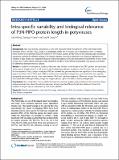Por favor, use este identificador para citar o enlazar a este item:
http://hdl.handle.net/10261/92951COMPARTIR / EXPORTAR:
 SHARE SHARE
 CORE
BASE CORE
BASE
|
|
| Visualizar otros formatos: MARC | Dublin Core | RDF | ORE | MODS | METS | DIDL | DATACITE | |

| Campo DC | Valor | Lengua/Idioma |
|---|---|---|
| dc.contributor.author | Hillung, Julia | - |
| dc.contributor.author | Elena, Santiago F. | - |
| dc.contributor.author | Cuevas, José M. | - |
| dc.date.accessioned | 2014-03-04T16:04:54Z | - |
| dc.date.available | 2014-03-04T16:04:54Z | - |
| dc.date.issued | 2013 | - |
| dc.identifier | doi: 10.1186/1471-2148-13-249 | - |
| dc.identifier | issn: 1471-2148 | - |
| dc.identifier.citation | BMC Evolutionary Biology 13 (2013) | - |
| dc.identifier.uri | http://hdl.handle.net/10261/92951 | - |
| dc.description.abstract | Background:Pipo was recently described as a new ORF encoded within the genome of the Potyviridae family members (PNAS 105:5897-5902, 2008). It is embedded within the P3 cistron and is translated in the +2 reading frame relative to the potyviral long ORF as the P3N-PIPO fusion protein. In this work, we first collected pipo nucleotide sequences available for different isolates of 48 Potyvirus species. Second, to determine the biological implications of variation in pipo length, we measured infectivity, viral accumulation, cell-to-cell and systemic movements for two Turnip mosaic virus (TuMV) variants with pipo alleles of different length in three different susceptible host species, and tested for differences between the two variants. Results: In addition to inter-specific variation, there was high variation in the length of the PIPO protein among isolates within species (ranging from 1 to 89 amino acids). Furthermore, selection analyses on the P3 cistron did not account for the existence of stop codons in the pipo ORF, but showed that positive selection was significant in the overlapping region for Potato virus Y (PVY) and TuMV. In some cases, variability in length was associated with host species, geographic provenance and/or other strain features. We found significant empirical differences among the phenotypes associated with TuMV pipo alleles, though the magnitude and sign of the effects were host-dependent. Conclusions: The combination of computational molecular evolution analyses and experiments stemming from these analyses provide clues about the selective pressures acting upon the different-length pipo alleles and show that variation in length may be maintained by host-driven selection. © 2013 Hillung et al.; licensee BioMed Central Ltd. | - |
| dc.description.sponsorship | Funding for this work was provided by the Spanish Direccion General de Investigacion Cientifica y Tecnica grant BFU2012-30805 (to SFE), a predoctoral fellowship from the Spanish Ministerio de Economia y Competitividad (to JH), and a postdoctoral contract from CSIC JAE-doc program (to JMC). | - |
| dc.publisher | BioMed Central | - |
| dc.relation.isversionof | Publisher's version | - |
| dc.rights | openAccess | - |
| dc.title | Intra-specific variability and biological relevance of P3N-PIPO protein length in potyviruses | - |
| dc.type | artículo | - |
| dc.identifier.doi | 10.1186/1471-2148-13-249 | - |
| dc.date.updated | 2014-03-04T16:04:54Z | - |
| dc.description.version | Peer Reviewed | - |
| dc.language.rfc3066 | eng | - |
| dc.identifier.pmid | 24225158 | - |
| dc.type.coar | http://purl.org/coar/resource_type/c_6501 | es_ES |
| item.openairetype | artículo | - |
| item.grantfulltext | open | - |
| item.cerifentitytype | Publications | - |
| item.openairecristype | http://purl.org/coar/resource_type/c_18cf | - |
| item.fulltext | With Fulltext | - |
| Aparece en las colecciones: | (IBMCP) Artículos | |
Ficheros en este ítem:
| Fichero | Descripción | Tamaño | Formato | |
|---|---|---|---|---|
| Hillung et al. BMC Evol. Biol.pdf | 486,42 kB | Adobe PDF |  Visualizar/Abrir |
CORE Recommender
PubMed Central
Citations
7
checked on 10-abr-2024
SCOPUSTM
Citations
16
checked on 16-abr-2024
WEB OF SCIENCETM
Citations
16
checked on 25-feb-2024
Page view(s)
285
checked on 23-abr-2024
Download(s)
250
checked on 23-abr-2024
Google ScholarTM
Check
Altmetric
Altmetric
Artículos relacionados:
NOTA: Los ítems de Digital.CSIC están protegidos por copyright, con todos los derechos reservados, a menos que se indique lo contrario.
